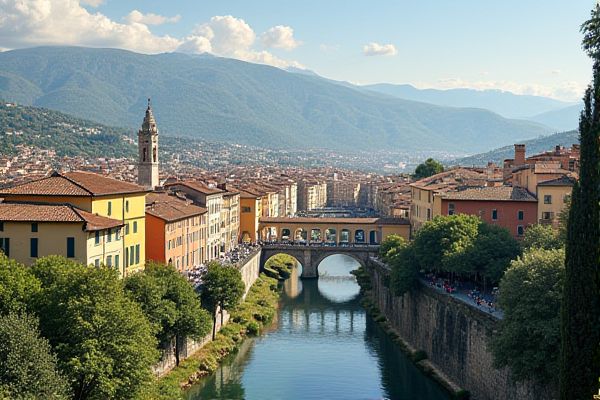
What to know as new resident in Italy: Italian visa and residency requirements. Renting vs. buying property differences. Italian healthcare system access. Cost of living variations. Regional cultural differences. Italian language basics. Public transportation options. Banking and financial setup. Italian cuisine and dining etiquette. Local market shopping tips.
Italian visa and residency requirements.
Non-EU citizens seeking to obtain residency in Italy must apply for a long-term visa, accompanied by essential documents such as a valid passport and proof of substantial and stable private income. Applicants must also present a registered lease or deed for property in Italy, along with a letter detailing their intention to move. This particular visa, which does not permit the recipient to work, requires individuals to demonstrate adequate financial assets to support any dependents. More detailed information can be found on the Consulate of Italy in New York's website.
Renting vs. buying property differences.
Renting in Italy is recommended for those seeking flexibility, a limited budget, or uncertainty about long-term plans, while buying is more suitable for those looking for stability, customization, and potential rental income. Although purchasing a home involves higher upfront costs and complex bureaucratic processes, it can be worthwhile for individuals with a long-term vision. For further insights on these considerations, visit Moon Travel Guides to explore more about the housing landscape in Italy.
Italian healthcare system access.
As a new resident in Italy, you can access the public healthcare system by registering with the National Health Service (SSN) at your local Azienda Sanitaria Locale (ASL) office. You'll need to provide proof of residency, an Italian ID card, and a tax code. Once registered, you will receive a Tessera Sanitaria (Italian Health Insurance Card) which grants you access to healthcare services. For more detailed information, visit the Italian Healthcare System guide.
Cost of living variations.
The cost of living in Italy varies significantly based on the location, with major cities like Milan and Rome being more expensive due to higher rent, food, and leisure costs. In contrast, smaller towns and southern cities like Palermo and Naples offer a more affordable lifestyle, with monthly costs for a single person ranging from EUR1,400 to EUR1,600 including rent. For more detailed insights, explore the Cost of Living in Italy to better understand how different Italian locations can impact your budget.
Regional cultural differences.
Italy is characterized by significant regional cultural differences, with each region boasting its own unique culture, cuisine, and traditions. Lombardy is known as a fashion and financial hub, while Tuscany is celebrated for its art and wine. Campania captivates with its volcanic landscapes and world-famous pizza, while Sicily offers a rich cultural heritage stemming from Greek, Roman, Arab, and Norman influences. To delve deeper into these fascinating contrasts, consider Exploring Italy's Regional Differences and uncover the diverse identities that shape this captivating country.
Italian language basics.
To get started as a new resident in Italy, focus on learning basic Italian words and phrases such as greetings ("Ciao," "Arrivederci"), common expressions ("Grazie," "Per favore"), simple questions ("Come ti chiami?", "Quanto costa?"), and basic verbs ("Essere," "Avere," "Vivere"). By familiarizing yourself with these fundamental elements of the language, you'll be able to navigate daily interactions more smoothly. For a comprehensive guide on essential Italian, consider exploring the resources available on Berlitz, which offers valuable insights into mastering these expressions effectively.
Public transportation options.
In Italy, public transportation includes buses, trams, metro lines, and trains, with options like car-sharing and scooter rental for short trips. Tickets must be purchased and validated before boarding, and day or multi-day passes can be more economical for frequent travel. For more detailed information on how to navigate these services, the Italia website provides practical tips and guidance for exploring the country's extensive transportation network.
Banking and financial setup.
To set up banking in Italy, you need a proof of ID, Italian address and legal residence status, an Italian fiscal code, and proof of employment or student status. Registering as an Italian resident can provide more advantageous bank conditions and other benefits such as access to the Italian Health System and dedicated utility offers.
Italian cuisine and dining etiquette.
To navigate Italian cuisine and dining etiquette, it's essential to wait for everyone to be served before eating, use bread to mop up sauce, use utensils correctly, keep hands visible on the table, and avoid certain practices like using cappuccino as a dinner beverage or asking for parmesan on inappropriate dishes. Additionally, respecting local meal times, using olive oil for bread, and enjoying meals slowly and socially are key components of the dining experience. For a more detailed guide, you can explore the Italian Table Manners to enhance your understanding of these cultural nuances.
Local market shopping tips.
To navigate local markets in Italy, it's beneficial to learn basic Italian phrases and bring cash for ease of transactions. Engaging with shop owners not only helps build relationships but also provides invaluable insights into Italian food and culture. When exploring, don't hesitate to ask vendors for recommendations, as this can enhance your shopping experience significantly. Furthermore, it's important to understand the various types of shops, such as *macelleria* for meat, *fruttivendolo* for fresh produce, and *panificio* for baked goods. For a detailed guide on exploring these charming markets, you can refer to Local Markets In Italy and discover more about the vibrant local shopping scene.
